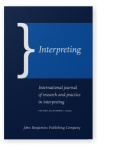Vol. 25:1 (2023) ► pp.61–86
“Feel sorry for Miss translator!!!”
A danmu-based case study of Bilibili users’ parasocial interactions about the ad hoc interpreter on screen
This article approaches user reception of interpreting events by investigating video users’ parasocial interactions about a specific interpreter on the danmu interface. The video of Chinese athlete Sun Yang’s public hearing (facilitated by an ad hoc interpreter) hosted on the Chinese video-sharing site, Bilibili, was chosen as a case study. Proceeding from an adapted parasocial interaction framework that features nine underlying parasocial processes, this study categorizes and analyses users’ danmu comments directed at the interpreter, mainly qualitatively but also quantitatively. It also examines them as manifestations or verbalizations of their parasocial interactions with the interpreter on screen in cognitive and affective dimensions. The findings show users’ noticeable preference for engaging in evaluation- and comprehension-oriented interactions and expressing their sympathy and empathy towards the interpreter. The findings also show that the parasocial interaction framework usefully accommodates a plethora of user reactions to the interpreter and their performance and offers a way of investigating relevant utterances systematically in a seemingly chaotic danmu space.
Article outline
- 1.Introduction
- 2.Approaches to user-oriented interpreting research
- 3. Danmu as a site for reception studies
- 4.The PSI analytical framework
- 5.Case study
- 5.1The data
- 5.2Data analysis
- 5.2.1Cognitive processes
- 5.2.1.1Attention allocation
- 5.2.1.2Comprehension of persona’s action and situation
- 5.2.1.3Activation of prior media and life experience
- 5.2.1.4Evaluations of persona and persona’s actions
- 5.2.1.5Anticipatory observation
- 5.2.1.6Construction of relationships between persona and self
- 5.2.2Affective processes
- 5.2.2.1Sympathy
- 5.2.2.2Empathy
- 5.2.2.3Emotional contagion
- 5.2.1Cognitive processes
- 6.Discussion and conclusion
- Acknowledgements
- Notes
-
References
